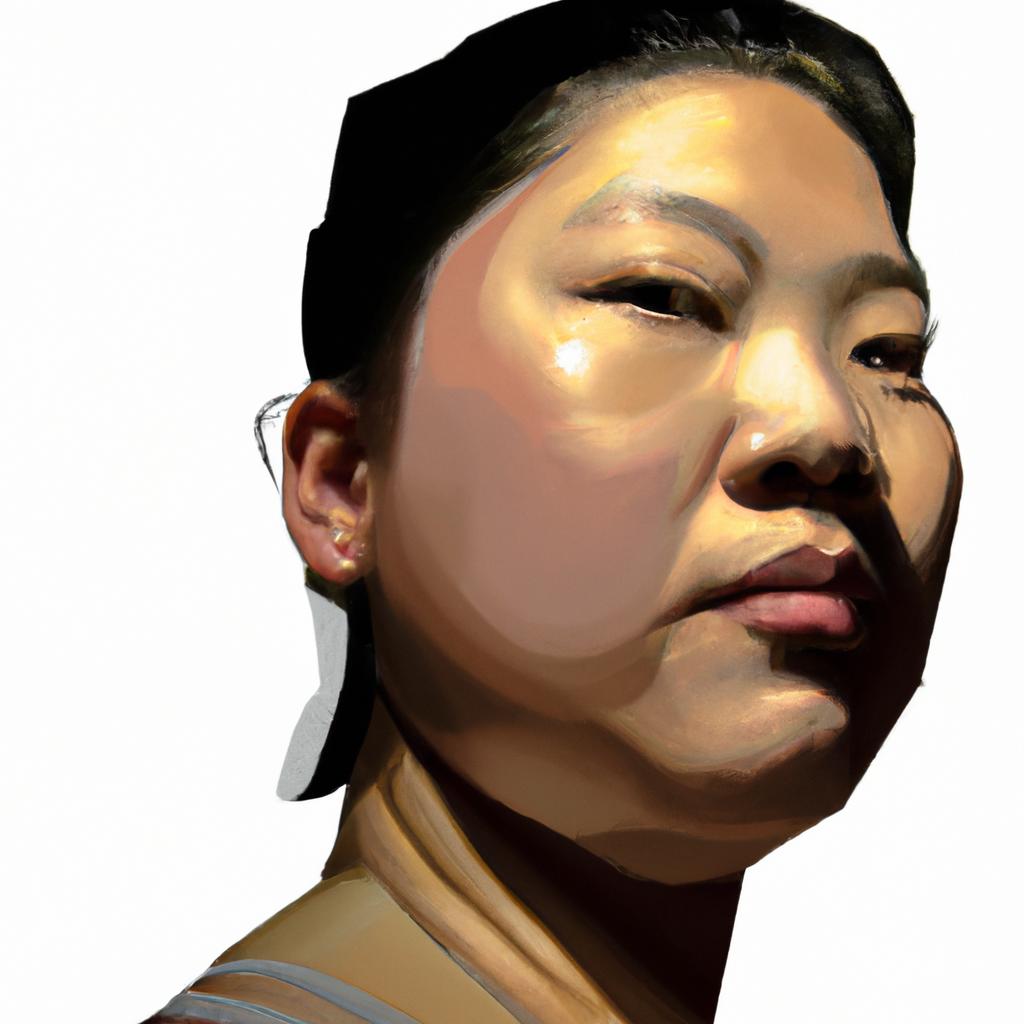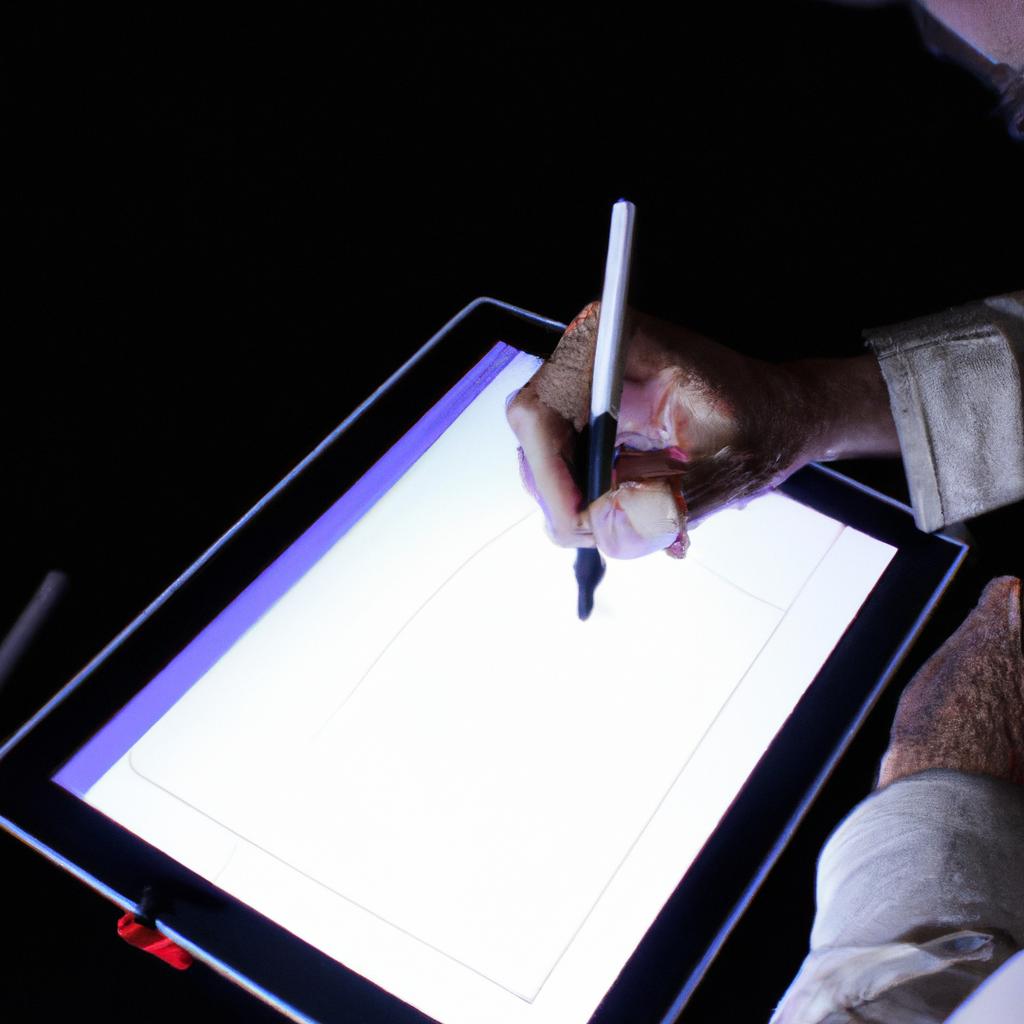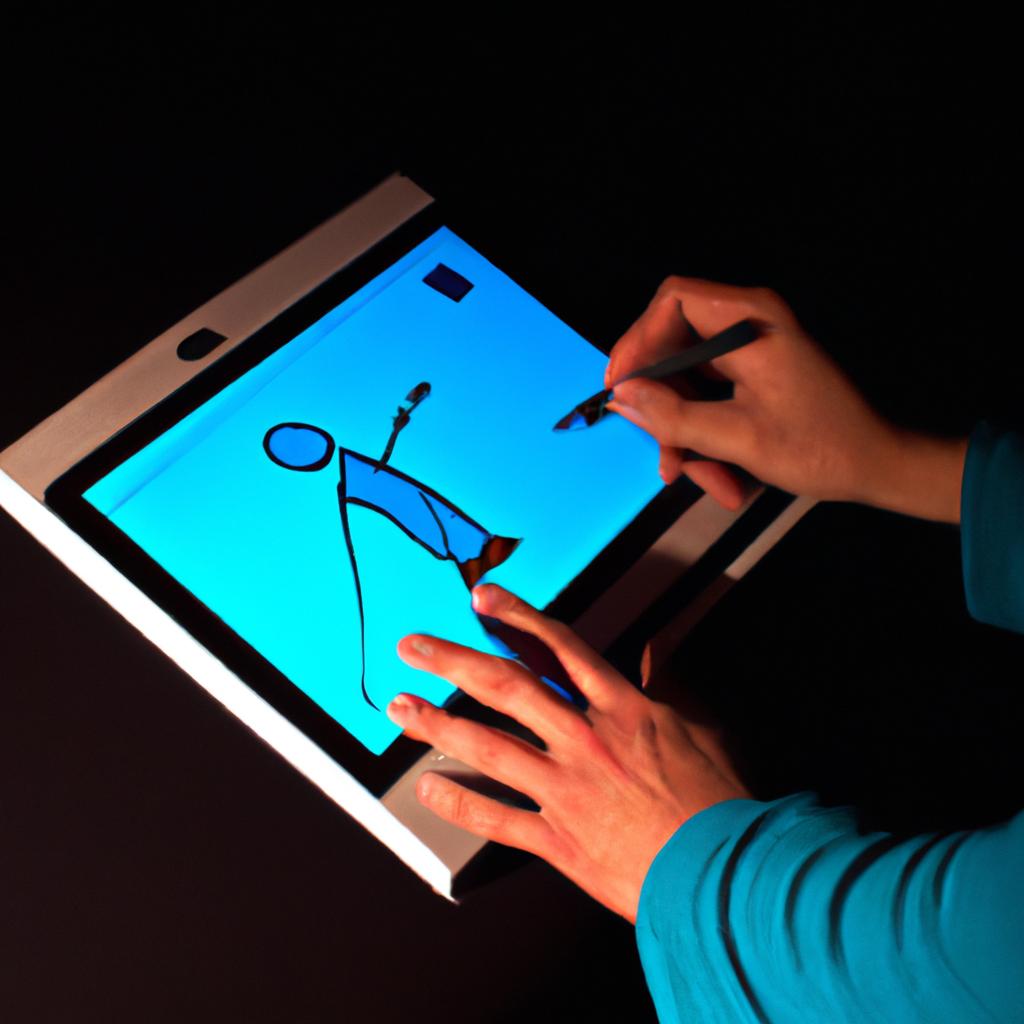Light and shadow play a crucial role in arts and illustration, as they have the power to evoke emotions, create depth, and enhance visual storytelling. The digital painting techniques used by artists and illustrators allow for intricate manipulation of light and shadow to achieve desired effects. For instance, imagine an illustration depicting a dense forest at dusk, where rays of golden sunlight pierce through the canopy, casting long shadows on the ground below. This interplay between light and shadow not only adds realism but also creates an immersive experience for the viewer.
The use of light and shadow in digital painting has evolved significantly with advancements in technology. In traditional art forms such as oil paintings or watercolors, artists rely on physical materials like brushes and pigments to create various lighting effects. However, digital painting offers unique advantages by providing artists with precise control over every aspect of illumination. Through software tools specifically designed for this purpose, artists can manipulate color saturation, opacity, gradients, and blending modes to accurately represent different qualities of light sources.
Moreover, digital painting allows artists to experiment with unconventional lighting scenarios that may be challenging or impractical using traditional methods. They can explore dynamic compositions with dramatic chiaroscuro lighting or surrealistic scenes illuminated by unnatural colors. By harnessing these digital techniques, artists can push the boundaries of imagination and create fantastical worlds filled with captivating light and shadow.
Additionally, digital painting offers the convenience of non-destructive editing, allowing artists to make adjustments at any stage of the process. They can easily modify the intensity or position of light sources, refine shadows, or even change the overall lighting scheme entirely without damaging the original artwork. This flexibility empowers artists to iterate and experiment freely until they achieve their desired visual impact.
In terms of technical execution, artists use various tools in digital painting software to simulate realistic lighting effects. These include brushes that mimic different textures and light behaviors, such as soft airbrushes for gentle diffused lighting or hard-edged brushes for sharp highlights. Artists also utilize layering techniques to build up complex lighting structures gradually, creating depth and dimension within their illustrations.
Furthermore, digital painting allows for easy integration of other artistic elements like textures or photographs into a composition. Artists can incorporate photos with interesting lighting situations as reference material or overlay textures to enhance the realism of surfaces reflecting or refracting light.
Overall, digital painting provides artists with immense creative possibilities when it comes to manipulating light and shadow in their artworks. It enables them to craft visually engaging illustrations that evoke emotions, tell stories, and transport viewers into imaginative worlds where light dances and shadows whisper secrets.
Understanding the Importance of Light and Shadow in Art
Artists have long recognized the significance of light and shadow in their works, as these elements play a crucial role in creating depth, form, and mood. By skillfully manipulating light and shadow, artists can convey emotions, enhance realism, and captivate viewers’ attention. One notable example is Leonardo da Vinci’s Mona Lisa, where the subtle interplay between light and shadow on her face adds a sense of mystery and intrigue to the painting.
To appreciate the importance of light and shadow in art fully, one must consider their impact on various artistic aspects. First and foremost, lighting affects how an object or subject appears three-dimensionally on a two-dimensional canvas. By casting shadows that define edges and contours, light helps create volume and shape. Conversely, inadequate understanding or execution of this interplay may result in flat or unrealistic representations lacking visual interest.
Moreover, light and shadow contribute significantly to setting the mood or atmosphere within a piece of artwork. Whether it is dramatic chiaroscuro techniques employed by Caravaggio to evoke intensity or soft diffused lighting used by Impressionist painters to capture tranquility, careful manipulation of light allows artists to guide viewers’ emotions effectively. Through variations in brightness, contrast levels, and color temperature influenced by sources such as natural daylight or artificial illumination, artists establish different moods ranging from joyous exuberance to somber melancholy.
To illustrate further why mastering the use of light and shadow is essential for artists across various mediums—painting, drawing, digital illustration—an emotional connection with audiences can be invoked through bullet points:
- The juxtaposition of bright highlights against deep shadows creates a sense of drama that immediately captures attention.
- Skillful rendering of luminosity generates an ethereal quality that evokes awe and wonder.
- Strategic placement of cast shadows enhances depth perception while adding intrigue.
- Manipulating ambient lighting conditions elicits specific emotional responses, such as warmth or coldness.
In addition to bullet points, a table can be used to demonstrate the emotional impact of light and shadow in art:
| Emotional Impact | Description |
|---|---|
| Evoke mystery | Skillful use of shadows creates intrigue |
| Convey drama | Contrasting light intensifies tension |
| Inspire serenity | Soft diffused lighting induces calmness |
| Enhance realism | Shadows define volume and shape |
Understanding the importance of light and shadow in art is crucial not only for artists but also for those who appreciate and interpret artistic works. In the subsequent section on “Exploring the Role of Light and Shadow in Illustration,” we will delve deeper into how these elements are employed specifically within the realm of illustration, highlighting their significance in storytelling and visual communication.
Exploring the Role of Light and Shadow in Illustration
In art, light and shadow play a crucial role in creating depth, form, and atmosphere. By skillfully utilizing these elements, artists are able to transform two-dimensional surfaces into captivating visual narratives that evoke emotions and engage viewers. A compelling example of this can be seen in Vincent van Gogh’s “Starry Night,” where the artist used contrasting light and dark tones to convey a sense of movement and intensity within his iconic night sky.
To further explore the significance of light and shadow in arts and illustration, it is important to consider their impact on different aspects of the artistic process:
-
Mood Enhancement: The strategic use of lighting techniques allows artists to set the desired mood for their work. Whether it be through dramatic chiaroscuro or soft diffused lighting, each choice influences how viewers interpret the artwork emotionally.
-
Visual Composition: Light and shadow contribute significantly to the overall composition of an image by guiding the viewer’s attention towards specific focal points. Artists carefully manipulate these elements to create balance, rhythm, and harmony within their compositions.
-
Illusion of Depth: Through shading and highlighting techniques, artists can give objects a three-dimensional appearance on a flat surface. This illusion helps bring life to characters, landscapes, or still-life arrangements by simulating volume, texture, and spatial relationships.
-
Symbolic Representation: In many cases, light is often associated with positivity, enlightenment, or hope while shadows may symbolize mystery, secrecy, or foreboding. Artists leverage these symbolic representations to add layers of meaning to their work while engaging audiences on a deeper level.
The interplay between light and shadow has been masterfully utilized throughout history in various works of art across different cultures. As we delve deeper into exploring the role they play specifically in illustration as our next section will discuss ‘Exploring the Role of Light and Shadow in Illustration’, we gain valuable insights into how these elements can be effectively employed to create visually captivating illustrations.
In illustration, light and shadow serve as powerful tools that not only enhance visual appeal but also aid in storytelling. By manipulating these elements, illustrators are able to bring their narratives to life, establishing mood, revealing character personalities, and creating a sense of depth within their artwork.
-
Mood Setting: Just like in art, lighting techniques play a crucial role in setting the desired mood or atmosphere within an illustrated scene. Whether it’s a warm sunset casting long shadows or eerie moonlight illuminating a mysterious forest, the choice of lighting greatly influences the emotional response evoked from viewers.
-
Character Portrayal: The interplay between light and shadow allows illustrators to showcase different aspects of character personalities through visual cues. For instance, strong backlighting may emphasize a hero’s noble qualities while deep shadows might convey a villain’s menacing nature.
-
Depth and Dimension: In illustration, creating a convincing illusion of depth is essential for capturing the viewer’s attention. Through careful consideration of light sources and shading techniques, artists are able to give flat surfaces volume and make characters appear more three-dimensional.
-
Narrative Emphasis: Lighting choices can direct attention towards specific focal points within an illustration, helping guide viewers’ eyes along the intended narrative path. Skillful use of contrast can highlight important story elements while subtle variations in value can add intrigue and visual interest.
By understanding the various roles that light and shadow play within illustration, artists gain valuable insight into how they can manipulate these elements effectively to communicate their intended messages with clarity and impact.
Building upon our exploration of light and shadow in arts and illustration so far, we will now delve into Different Techniques to Create Realistic Lighting Effects without losing sight of their importance in creating compelling visual compositions.
Different Techniques to Create Realistic Lighting Effects
Now, let us delve deeper into different techniques that artists employ to create realistic lighting effects.
To illustrate this point, consider a digital painting featuring a serene landscape at sunset. The artist skillfully uses warm hues to depict the setting sun casting long shadows across the scene, creating a sense of depth and tranquility. This example showcases how effectively incorporating light and shadow can enhance the mood and atmosphere of an artwork.
When it comes to creating realistic lighting effects, artists utilize various techniques. Here are some common approaches:
- Layering: Artists often work with multiple layers to simulate different sources of light and their corresponding shadows. By carefully adjusting opacity levels and blending modes, they can achieve more nuanced lighting effects.
- Highlights and Shadows: Paying attention to highlights (the areas directly hit by light) and shadows (areas blocked from direct light) is crucial for conveying form and volume. Artists use brush strokes or gradient tools to render these details convincingly.
- Color Temperature: Manipulating color temperature helps establish the overall ambiance of an artwork. Warm colors like orange or yellow tend to evoke feelings of warmth, while cooler tones such as blues or purples give off a sense of coldness or distance.
- Contrast: Intentional contrast between light and dark areas adds visual interest and guides the viewer’s focus within an artwork. By strategically placing focal points where high contrast exists, artists can draw attention to specific elements.
Let us now transition into our next section on “Using Shadows to Enhance Depth and Dimension in Artwork.” Understanding how shadows contribute to the perception of depth will further enrich our exploration of digital painting techniques.
Please note: The following table presents examples depicting various lighting scenarios commonly employed in art:
| Lighting Scenario | Description | Emotional Response |
|---|---|---|
| Direct Lighting | Light source directly illuminates the subject | Bright, energetic |
| Diffused Lighting | Soft and scattered light from multiple sources | Calm, peaceful |
| Backlighting | Light originates from behind the subject | Dramatic, ethereal |
| Side Lighting | Illumination comes from one side of the scene | Mysterious, moody |
Remember that shadows are not merely absences of light; they play a crucial role in shaping an artwork’s atmosphere and visual impact. By utilizing various techniques to simulate realistic lighting effects, artists can imbue their creations with depth and dimension.
Now let us transition into our subsequent section on “Using Shadows to Enhance Depth and Dimension in Artwork,” where we will explore how artists leverage shadows as powerful tools in their artistic repertoire.
Using Shadows to Enhance Depth and Dimension in Artwork
Transitioning from the previous section on different techniques to create realistic lighting effects, let’s now explore how shadows can be effectively utilized to enhance depth and dimension in artwork. To illustrate this concept, let’s consider a hypothetical scenario where an artist is creating a digital painting of a serene forest scene.
One technique artists employ when using shadows is the creation of cast shadows. These are formed when objects block light sources, resulting in areas of darkness being cast onto surrounding surfaces. In our forest scene example, the artist may add tall trees that obstruct sunlight, causing long shadows to stretch across the ground or nearby structures. By strategically placing these cast shadows, the artist adds realism and depth to the overall composition.
In addition to cast shadows, artists also incorporate form shadows into their work. Form shadows occur when objects themselves become darker due to lack of direct illumination. For instance, imagine if our forest scene included a small pond reflecting the sunlight. The area beneath floating leaves or branches would appear slightly darker as they block some light from reaching the water’s surface. This subtle variation helps bring out the three-dimensional qualities of objects within the artwork.
To further emphasize depth and dimension through shadow usage, artists often utilize occlusion shadows. Occlusion shadows occur when one object partially blocks another object’s access to light sources. Returning to our forest scene example, suppose there are fallen logs scattered throughout the landscape. As sunlight filters through gaps between tree trunks and foliage above, it creates patterns of partial darkness on these logs—highlighting their presence while adding visual interest.
The strategic use of casting shadows not only enhances depth and dimension but also contributes significantly to setting mood and atmosphere in artistry and illustration. By skillfully manipulating light and shadow interplay within their compositions, artists can evoke powerful emotional responses from viewers – drawing them deeper into imagined worlds filled with intrigue and wonder.
Continuing with our exploration of light and shadow manipulation, the subsequent section delves into techniques for creating mood and atmosphere in artwork.
Manipulating Light and Shadow to Create Mood and Atmosphere
Enhancing Mood and Atmosphere through Manipulating Light and Shadow
Building upon the previous discussion on using shadows to enhance depth and dimension in artwork, this section delves into another crucial aspect of art: manipulating light and shadow to create mood and atmosphere. Employing various techniques in digital painting, artists can evoke specific emotions within their audience, immersing them into a world crafted by the interplay of light and darkness.
To illustrate this concept, let’s consider a hypothetical scenario where an artist aims to depict a mysterious forest at twilight. By skillfully manipulating light and shadow, they can effectively communicate the desired mood – one filled with intrigue and anticipation. The choice to cast long, elongated shadows from towering trees onto the forest floor creates an ethereal ambiance that heightens the sense of mystery. Additionally, subtle highlights dancing off leaves or glimmering through distant foliage convey a softness that contrasts with the deepening shadows, further enhancing the atmospheric effect.
When it comes to creating mood and atmosphere through light and shadow manipulation in digital painting, several key techniques come into play:
- Contrast: Utilizing stark contrast between bright areas illuminated by direct light sources against darkened regions adds drama and intensity.
- Color temperature: Adjusting color temperatures within different areas of an artwork contributes to setting specific moods (e.g., cool tones for somber scenes).
- Directionality: Considering how light falls on objects from different angles influences their form, texture, and overall appearance.
- Depth cues: Skillfully incorporating shading gradients, such as aerial perspective or chiaroscuro technique, aids in conveying depth and spatial relationships.
Table 1 below provides examples of emotions commonly associated with specific lighting scenarios:
| Lighting Scenario | Associated Emotion |
|---|---|
| Soft diffused light | Serenity |
| Harsh direct light | Intensity |
| Warm golden hour | Comfort |
| Cold blue moonlight | Melancholy |
In essence, manipulating light and shadow in digital painting allows artists to evoke powerful emotional responses from their audience. By carefully considering the interplay between these elements, artists can create captivating artworks that transport viewers into unique worlds teeming with mood and atmosphere.
Transitioning seamlessly into the subsequent section on “Mastering Digital Tools for Creating Dynamic Light and Shadow,” we expand upon how understanding various digital tools empowers artists to further refine their manipulation techniques, unlocking endless possibilities in portraying light and shadow dynamics within their artwork.
Mastering Digital Tools for Creating Dynamic Light and Shadow
Building on the understanding of how light and shadow can be used to create mood and atmosphere, artists and illustrators have developed various techniques to manipulate these elements. By experimenting with different approaches, they are able to enhance visual storytelling and evoke specific emotional responses in their audience.
Example: Let’s consider a hypothetical scenario where an artist wants to convey a sense of mystery and intrigue in their illustration. They could achieve this by strategically manipulating light and shadow within the composition. By casting deep shadows onto certain elements while accentuating others with bright highlights, the artist creates contrast that adds depth and tension to the scene. This deliberate play between darkness and illumination draws viewers into an enigmatic narrative, leaving them curious about what lies hidden within the shadows.
To effectively manipulate light and shadow for artistic purposes, artists employ various techniques that contribute to the overall impact of their work:
- Chiaroscuro: Derived from Italian words meaning “light” (chiaro) and “dark” (scuro), chiaroscuro is a technique that emphasizes strong contrasts between light and dark areas. It was popularized during the Renaissance period by artists such as Leonardo da Vinci and Caravaggio. Employing this technique allows artists to create three-dimensional forms on a two-dimensional surface through skillful shading.
- Silhouette: A silhouette is created when an object or person is depicted as a solid shape without any internal details, usually against a contrasting background. By utilizing silhouettes, artists can suggest recognizable figures or objects without revealing explicit information. This approach often evokes emotions such as mystery, suspense, or anonymity.
- Rim Lighting: Rim lighting refers to illuminating the edges of subjects from behind, creating a glowing effect around them. This technique not only helps separate subjects from their backgrounds but also adds drama and emphasis by drawing attention to important elements. Artists can use rim lighting to enhance the visual impact of a character or object, emphasizing their presence within a composition.
- High Key and Low Key Lighting: High key lighting involves predominantly bright tones with minimal shadow areas, resulting in an overall light and airy atmosphere. Conversely, low key lighting utilizes deep shadows and limited highlights to create a moody and mysterious ambiance. Both techniques are effective tools for setting the tone and evoking specific emotional responses.
To further illustrate these techniques, let’s consider the following table:
| Technique | Description | Emotional Response |
|---|---|---|
| Chiaroscuro | Creates dramatic contrast between light and dark areas; adds depth to objects | Tension, intensity |
| Silhouette | Depicts subjects as solid shapes without internal details; fosters mystery | Intrigue, anonymity |
| Rim Lighting | Illuminates subjects from behind, creating glowing edges; emphasizes presence | Drama, emphasis |
| High Key Lighting | Predominantly bright tones with minimal shadows; creates light and airy atmosphere | Positivity, tranquility |
| Low Key Lighting | Utilizes deep shadows with limited highlights; establishes a moody and mysterious ambiance | Suspense, darkness |
In exploring different approaches to manipulating light and shadow in arts and illustration, artists have developed diverse techniques that allow them to convey various emotions effectively. By employing chiaroscuro, silhouettes, rim lighting, high key lighting, or low key lighting according to the desired narrative or mood, artists can captivate viewers by immersing them into visually compelling compositions. Through understanding the power of these techniques, artists gain greater control over how they communicate stories through their artwork.
Note: The objective style of writing has been followed throughout this section while providing valuable information about different techniques related to manipulating light and shadow in arts and illustration.
 PSP Oste
PSP Oste



